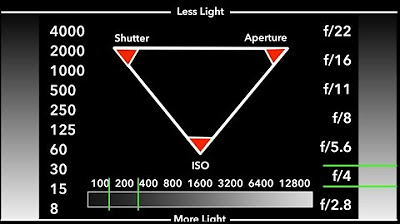What is Aperture ISO and Shutter speed? Exposure Beginners Guide
Summary
TLDRThis video provides essential insights into achieving proper exposure in photography and videography. It covers the importance of using histograms and zebras to avoid underexposure and overexposure, along with practical tips for setting up your camera. Viewers learn how to effectively utilize ND filters for managing light and maintaining desired aperture settings, as well as the benefits of polarizing filters for enhancing color. The video also discusses shutter and aperture priority modes, empowering users to take control of their exposure settings confidently. Perfect for those looking to improve their shooting techniques.
Takeaways
- 😀 Proper exposure is crucial; slightly underexposing (around -0.3 to -0.7) is preferable to overexposing.
- 📊 The histogram visually represents tonal values, with the left side indicating dark tones and the right side indicating light tones.
- 🐍 Use zebra patterns to identify overexposed areas, especially when shooting skin tones, by adjusting settings until they disappear.
- 💡 If images are underexposed, introduce additional lighting or adjust ISO cautiously to maintain quality.
- 🕶️ Neutral density (ND) filters act like sunglasses for your camera, allowing for proper exposure without altering light color.
- ⚙️ Use shutter priority or aperture priority modes to maintain desired settings while letting the camera adjust the other variable.
- 🌄 ND filters are also useful for long exposure photography, helping to manage light when shooting in bright conditions.
- 🎨 Polarizing filters enhance colors and reduce reflections, making them ideal for landscape photography.
- 🔄 Understanding how to manipulate exposure settings gives you more control over your camera in different environments.
- 🎥 Mastering these techniques helps achieve better results in both photography and videography, providing a solid foundation for creative work.
Q & A
Why is it generally better to keep images slightly underexposed?
-Slightly underexposed images allow for better recovery in post-production compared to overexposed images, which are more difficult to correct.
What does a histogram represent in photography?
-A histogram shows the graphical representation of tonal values in an image, with black tones on the left and white tones on the right, helping to assess exposure levels.
How can zebras be used to check exposure?
-Zebras are overlay stripes that indicate overexposed areas in the image, allowing the photographer to adjust settings until the zebras disappear for proper exposure.
What is the function of ND filters in photography?
-ND filters act like sunglasses for the camera, reducing light intensity without changing the color, which helps maintain proper exposure while keeping desired aperture and shutter speed.
What are the differences between shutter priority and aperture priority modes?
-In shutter priority mode, the photographer sets the shutter speed while the camera adjusts aperture and ISO. In aperture priority mode, the aperture is set and the camera adjusts shutter speed and ISO.
Why is knowing your camera's ISO limits important?
-Understanding the ISO limits of your camera is crucial to avoid excessive noise and loss of image quality, especially at higher ISO settings.
What are the potential downsides of increasing shutter speed to control exposure?
-Increasing shutter speed can lead to jittery footage in video and reduce motion blur in photography, compromising the desired aesthetic effects.
How do variable ND filters differ from fixed ND filters?
-Variable ND filters allow for adjustable light reduction by twisting the filter, providing flexibility without needing to switch between multiple fixed filters.
What role do polarizing filters play in photography?
-Polarizing filters block light reflected off surfaces like water and enhance colors, helping to achieve more vibrant and saturated images, particularly in landscape photography.
How does understanding stops of light help in exposure management?
-Understanding stops of light helps photographers make informed adjustments to ISO, shutter speed, and aperture, ensuring proper exposure and creative control over the image.
Outlines

Cette section est réservée aux utilisateurs payants. Améliorez votre compte pour accéder à cette section.
Améliorer maintenantMindmap

Cette section est réservée aux utilisateurs payants. Améliorez votre compte pour accéder à cette section.
Améliorer maintenantKeywords

Cette section est réservée aux utilisateurs payants. Améliorez votre compte pour accéder à cette section.
Améliorer maintenantHighlights

Cette section est réservée aux utilisateurs payants. Améliorez votre compte pour accéder à cette section.
Améliorer maintenantTranscripts

Cette section est réservée aux utilisateurs payants. Améliorez votre compte pour accéder à cette section.
Améliorer maintenantVoir Plus de Vidéos Connexes

APERTURE, SHUTTER SPEED AND ISO/ THE EXPOSURE TRIANGLE MADE EASY!

Gear untuk Hunting Foto Shutterstock di Labuan Bajo pakai Mark Ryden MR2913

How to Make Money $$$ as a BEGINNER Videographer

Dental Photography Basics - How to Take a Quality Dental Photo - Proper Exposure

Understanding Exposure: The Exposure Triangle with Mark Wallace

BERSIH BERSIH KAMERA DAN LENSA | VIEW INDONESIA
5.0 / 5 (0 votes)
